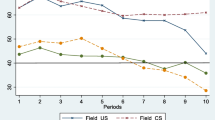Abstract
An input-based incentive approach for controlling an agricultural non-point source pollution problem is developed. A regulatory agency designs a tax scheme and an investment policy to increase its informational base, in order to obtain the desirable water use and emissions for a set of agricultural producers whose individual water use and emissions cannot be observed without costly monitoring. The agency invests in order to increase observability of water use and emissions, and taxes the observed variables. Learning effects enhance the process of acquiring information about the individual producers' behavior. The optimal tax scheme and the cost minimizing monitoring program are determined.
Similar content being viewed by others
References
K. Arrow and M. Kurz, Public Investment, the Rate of Return and Optimal Fiscal Policy (Johns Hopkins Univ. Press, 1970).
R. Barro and X. Sala-i-Martin, Economic Growth (McGraw-Hill, 1995).
W. Boggess, E. Flaig and R. Fonyo, Florida's experience with managing nonpoint source phosphorus runoff in lake Okeechobee, in: Theory, Modeling, and Experience in the Management of Nonpoint-Source Pollution, eds. C. Russell and J. Shogren (Kluwer Academic, Boston, MA, 1993).
J.B. Braden and K. Segerson, Informational problems in the design of nonpoint source pollution policy, in: Theory, Modeling, and Experience in theManagement of Nonpoint-Source Pollution, eds. C. Russell and J. Shogren (Kluwer Academic, Boston, MA, 1993) p. 1–36.
M.R. Caputo, How to do comparative dynamics on the back of an envelope in optimal control theory, Journal of Economic Dynamics and Control 14 (1990) 655–683.
A. Dinar, Measuring knowledge production of an agricultural research system, Technological Forecasting and Social Change 40 (1991) 249–259.
A. Dinar and J. Letey, Modeling Economic, Management and Policy Issues in Irrigated Agriculture (Praeger, Connecticut, 1997).
A. Dinar and A. Xepapadeas, Regulating water quantity and quality in irrigated agriculture, Journal of Environmental Management 54 (1998) 273–289.
J.W. Dunn and J.S. Shortle, Agricultural nonpoint-source pollution control in theory and practice, Marine Resource Economics 5 (1988) 259–270.
H. Farzin and J. Kaplan, Nonpoint source pollution control under incomplete and costly information, FEEM Working Papers No. 32 (1999).
C. Fershtman and S. Nitzan, Dynamic voluntary provisions of public goods, European Economic Review 35 (1991) 1057–1067.
D. Garvie and A. Keeler, Incomplete enforcement with endogenous regulatory choice, Journal of Public Economics 55 (1994) 141–162.
R.C. Griffin and D.W. Bromely, Agricultural runoff as a nonpoint externality: A theoretical development, American Journal of Agricultural Economics 64(3) (1982) 547–552.
R.W. Hexem and E.O. Heady, Water Production functions for Irrigated Agriculture (Iowa State Univ. Press, Ames, IA, 1978).
J.T. LaFrance and L.D. Barney, The envelope theorem in dynamic optimization, Journal of Economic Dynamics and Control 15 (1991) 355–385.
A.S. Malik, Permanent versus interim regulations: A game theoretic analysis, Journal of Environmental Economics and Management 21 (1991) 127–139.
E. Mansfield, Intrafirm rates of diffusion on an innovation, Review of Economics and Statistics 45 (1963) 348–359.
D.W. Nordhaus, Invention, Growth and Welfare: A Theoretical Treatment of Technical Change (MIT Press, Cambridge, MA, 1969).
OECD Environmental Policy: How to Apply Economic Instruments, Paris (1991).
M. Ribaudo, Water quality benefits from the conservation reserve program, Agricultural Economic report No. 606, Economic Research Service, U.S. Department of Agriculture, Washington, DC, February 1989.
K. Segerson, Uncertainty and incentives for nonpoint pollution control, Journal of Environmental Economics and Management 15 (1988) 87–98.
A. Seierstad and K. Sydsaeter, Optimal Control Theory with Economic Applications (North-Holland, 1987).
A.P. Xepapadeas, Environmental policy design and dynamic nonpoint-source pollution, Journal of Environmental Economics and Management 23 (1992) 22–39.
A. Xepapadeas, Non-point source pollution control, in: The Handbook of Environmental and Resource Economics, ed. J. van den Bergh (Edward Elgar, 1999).
A. Xepapadeas, Observability and choice of instrument mix in the control of externalities, Journal of Public Economics 56 (1995) 485–498.
Author information
Authors and Affiliations
Rights and permissions
About this article
Cite this article
Dinar, A., Xepapadeas, A. Regulating Water Quantity and Quality in Irrigated Agriculture: Learning by Investing under Asymmetric Information. Environmental Modeling & Assessment 7, 17–27 (2002). https://doi.org/10.1023/A:1015265912341
Issue Date:
DOI: https://doi.org/10.1023/A:1015265912341




